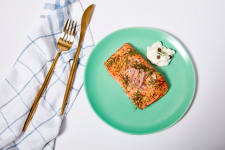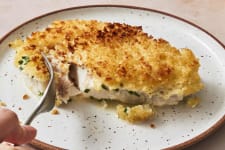
Spotlight on Our Team Member Melissa Allen, in Celebration of National Native American Heritage Month
November 10th, 2021How a Unique Cultural Heritage and Subsistence Living Shaped This Native Alaskan's Life
It’s such an honor to work alongside an individual who shows up to everything they do with equal parts assertiveness, creativity and smiles — and it’s my pleasure to say that Melissa Allen, one of our Member Experience Specialists, is very much that person.
In celebration of National Native American Heritage Month and Veterans Day, we’re shining a light on Melissa and her Native Alaskan roots and upbringing, with a special Q&A interview, in which she graciously shares about her grandfather’s military service — for which we are so grateful! — her grandmother’s Aleut-Russian culture, subsistence living and growing up fishing on one of Alaska’s coasts.
Melissa, you have a really interesting and unique cultural heritage. Can you tell us a bit about your family?
My family is pretty big. My grandparents lived outside of Anchor Point, Alaska, and had 7 kids. And those kids had kids, and some of those kids have kids. My grandmother was part Aleut and part Russian, and born and raised in Seldovia, Alaska which in 2010 had a census of 255 people. So, a very small town across the bay from Homer. My grandfather fought in World War II and after the war found himself up in Alaska homesteading. Family gatherings were filled with stories, food, drinks and a lot of laughter. Most people in my family lived in Anchorage, a four hour drive away, but I don’t remember a summer that wasn’t spent on the beach with them fishing, celebrating birthdays, or a holiday. So much of my childhood was spent with them doing one thing or another on the beach or their homestead.
You mentioned that you grew up subsistence fishing on the beach every summer with your family. Can you share with us a bit about what that was like?
Fishing with the family was very fun. We would always set up a beach set net. We signed up for a lot each summer for several dates with the tribal center. Depending on high tide, we would pack the net and load the four-wheelers on the trucks then the first wave of family would head out. They would set the net, so they were the ones to attach it to the rope that was already anchored out from the beach. Once it is attached, there is another rope maybe 30 feet away that you pull to drag the net into the water. If there are enough people, you don’t need a four-wheeler or ATV.
Then the second wave of family would pack the food, lawn chairs, drinks etc. and head out 45 minutes later to meet them. We would camp out for a long while. Long enough to pull the net in a few times to check and see what we got, pick the seaweed out, and pull it back in. During the time in between, it was a lot of hanging out by the fire and eating food.
A good memory I have is when someone would decide to eat one of the fish we caught. My dad would bring a huge pot, flour, eggs and some seasoning, and oil and he would deep fry fish on the beach 15 minutes after it was caught. When we were younger, the adults would cut the tails off the fish we were going to eat and we would roast the fishtails over the fire like hot dogs. Of course, there was very little meat on them but it was fun for us and made for a crispy snack.
How was the harvest prepared/cooked/treated? Who did this part?
It depends on who signed up for the net and whose net it was. I remember a good chunk of time we would keep the fish whole while it was in the freezer. It lasted longer in the freezer and kept it from burning. That fish would last us well over a year that way. After it was caught, we all cleaned off sand and slime, wrapped it up, marked it with an R or S (reds or silvers) and the year, it just went directly in the freezer.
There were some years we would get so much fish we could share with friends who would smoke it. And sometimes my grandma would make lox out of it. The lox was the one I remember well because she would have us help turn it every day. The two dishes I remember my grandmother making the most were Pirok and halibut caddy ganty — two dishes I only knew how to spell because of google searches. The recipes for them were so ingrained in our family that no one ever wrote them down.
Are there any Aleut culinary traditions that you can share?
Definitely the Pirok or the halibut caddy ganty. A lot of Alaska Native culture is combined now with Russian culture. So Pirok, I believe, is more of a Russian influenced dish but it is salmon pie that is a combination of both cultures. Our Pirok started with a pie crust on the bottom, a bottom layer of rice, a layer of steamed cabbage, sometimes boiled eggs (but I never liked it with eggs), a whole fillet of salmon, another layer of rice, sautéed onions, and then a top layer of pie crust. It went in the oven for 45 minutes and it was amazing. Everyone loved it and it was a dish you didn’t miss dinner for. This was the kind of dish my grandma would make for birthdays or when we would come visit her after being gone for a while. Later on we added Mai Ploy or jalapeños and it was even better.
How has Aleut culture impacted and influenced your life?
Since my grandparents lived on a homestead, a lot of the culture that I learned from them was subsistence living. I no longer live in an environment where I need to rely on those things, but a lot of the cooking and small things stuck with me. Things like eating the salmon skin or making lox. Or just really appreciating the value that salmon have in my life. And of course, those dishes I mentioned. I try to make all my friends try Pirok, halibut caddy ganty, and lox at some point. They are recipes I know I would never be able to forget, because as long as you paid a little attention, you had no choice but to learn them.
***
I hope you enjoyed learning about Melissa and her Aleut culture as much as I did.
Live Wild,
Monica
Pictured above: Melissa’s snapshots from a typical day camping out on the beach with the family in Anchor Point, Alaska. It’s a day to set up lawn chairs and chill with snacks and refreshments as everyone waits to see what swims into their beach set net.
P.S. You may have noticed we've been featuring cultural awareness months in our Anchor Points newsletters. It's part of our ongoing commitment to celebrate and promote diversity, inclusion and equity — which we aim to lovingly foster in our workplace and among our community. We invite you to read more of Monica's Anchor Points here and in your inbox every week.





